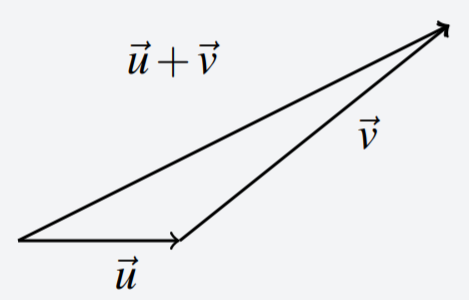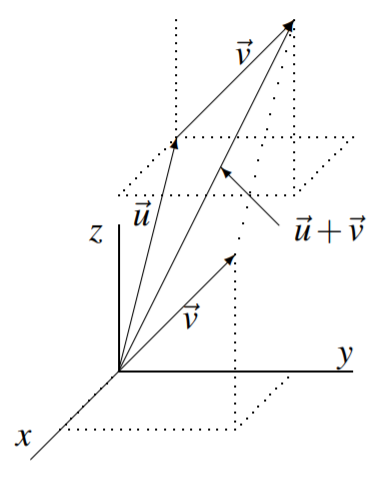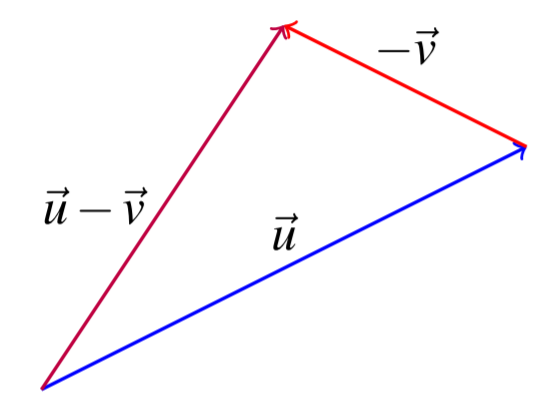4.3: Significado geométrico de la adición de vectores
- Page ID
- 114515
- Entender la adición de vectores, geométricamente.
Recordemos que un elemento de\(\mathbb{R}^{n}\) es una lista ordenada de números. Para el caso específico de\(n=2,3\) esto se puede utilizar para determinar un punto en el espacio bidimensional o tridimensional. Este punto se especifica en relación con algunos ejes de coordenadas.
Considera el caso\(n=3\). Recordemos que tomar un vector y moverlo sin cambiar su longitud o dirección no cambia el vector. Esto es importante en la representación geométrica de la adición de vectores.
Supongamos que tenemos dos vectores,\(\vec{u}\) y\(\vec{v}\) en\(\mathbb{R}^{3}\). Cada uno de estos se puede dibujar geométricamente colocando la cola de cada vector en\(0\) y su punto en\(\left( u_{1}, u_{2}, u_{3}\right)\) y\(\left( v_{1}, v_{2}, v_{3}\right)\) respectivamente. Supongamos que deslizamos el vector\(\vec{v}\) para que su cola se asiente en el punto de\(\vec{u}\). Sabemos que esto no cambia el vector\(\vec{v}\). Ahora, dibuja un nuevo vector desde la cola de\(\vec{u}\) hasta el punto de\(\vec{v}\). Este vector es\(\vec{u}+\vec{v}\).
La significación geométrica de la adición de vectores en\(\mathbb{R}^n\) para cualquiera\(n\) se da en la siguiente definición.
Dejar\(\vec{u}\) y\(\vec{v}\) ser dos vectores. Deslízate\(\vec{v}\) para que la cola de\(\vec{v}\) esté en el punto de\(\vec{u}\). Después dibuja la flecha que va desde la cola de\(\vec{u}\) hasta el punto de\(\vec{v}\). Esta flecha representa el vector\(\vec{u}+\vec{v}\).

Esta definición se ilustra en la siguiente imagen en la que\(\vec{u}+\vec{v}\) se muestra para el caso especial\(n=3\).

Observe el paralelogramo creado por\(\vec{u}\) y\(\vec{v}\) en el diagrama anterior. Entonces\(\vec{u} + \vec{v}\) es la diagonal dirigida del paralelogramo determinada por los dos vectores\(\vec{u}\) y\(\vec{v}\).
Cuando se tiene un vector\(\vec{v}\), su inversa aditiva\(-\vec{v}\) será el vector que tiene la misma magnitud\(\vec{v}\) pero la dirección opuesta. Cuando uno escribe\(\vec{u}-\vec{v,}\) el significado es\(\vec{u} + \left( -\vec{v}\right)\) como con los números reales. El siguiente ejemplo ilustra estas definiciones y convenciones.
Considere la siguiente imagen de vectores\(\vec{u}\) y\(\vec{v}\).

Esbozar una imagen de\(\vec{u}+\vec{v},\vec{u}-\vec{v}.\)
Solución
Primero haremos bosquejo\(\vec{u}+\vec{v}.\) Empezaremos por dibujar\(\vec{u}\) y luego en el punto de\(\vec{u}\), colocaremos la cola de\(\vec{v}\) como se muestra. Entonces\(\vec{u}+\vec{v}\) es el vector que resulta de dibujar un vector desde la cola de\(\vec{u}\) hasta la punta de\(\vec{v}\).

Siguiente considerar\(\vec{u}-\vec{v}.\) Esto significa A\(\vec{u}+\left( -\vec{v} \right) .\) partir de la descripción geométrica anterior de la adición de vectores,\(-\vec{v}\) es el vector que tiene la misma longitud pero que apunta en la dirección opuesta a\(\vec{v}\). Aquí hay una foto.



